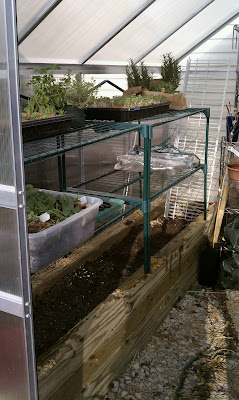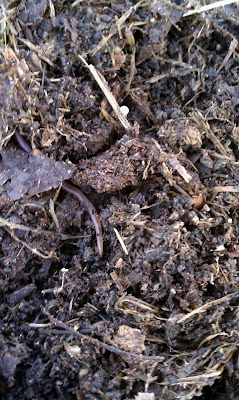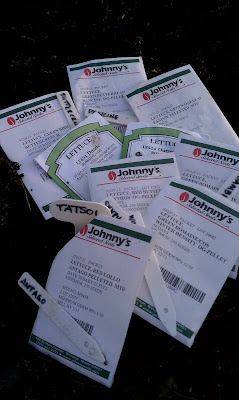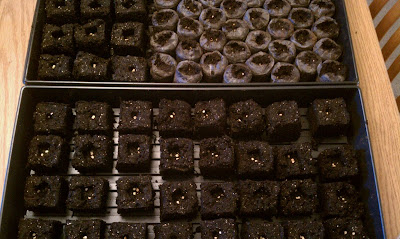Posted by
Jeph
on
Monday, March 21, 2011

Spent a big chunk of the last two days cleaning out winter experiments from the greenhouse, and items stored in the greenhouse over winter, and then building raised beds on either side which are then topped with "mini greenhouses" - the kind you buy at most big box stores that are typically made of green metal poles, plastic and wire shelves, covered with an optional clear plastic zip up cover.
I built the raised beds out of 4x4s, filling them with leftover potting soil from last year's pots, bagged composted manure and top soil, homemade compost, and bagged potting/veggie mix.
Each raised bed then had deep 5/8" holes drilled down into the front and back walls, which had 18" rebar stakes fit into them. Most of the rebar sticks out, over which I fit the green metal posts that run vertically in the mini greenhouses. From there I built up two layers of the greenhouse, basically splitting each mini greenhouse into two halves.
My plan is to try growing parthecarpic cukes and squash, and maybe a tomato plant or two, INSIDE the greenhouse this summer, using the raised beds. Before it's time for that the shelves will get used for seed starting and hardening off started in the basement. Stuff started indoors can't go straight outside... it's too drastic of a change for the plants.
Before too much longer I'll try starting the female-only veggies out in the raised beds... Hopefully they'll do well and start producing long before plants outside are doing their thing. Like squash, tomatoes, cukes etc can't go outside until late May around here!
The support braces under each wire shelf should double as support for tomatoes and cukes grown in the greenhouse.
Then come fall I plan to switch over to fall and winter veggies. Think spinach, lettuce, chard, kale, Asian greens, and who knows, maybe carrots??? Anything I hoped to grow out there last winter froze. But using Elliott Coleman's winter harvest technique, I hope this coming winter will be different. I can add layers of clear plastic domes and/or the mini greenhouse zip up covers to create buffered pockets, hopefully convincing the plants that they're a couple hardiness zones south of here. I can't do this to the point of growing heat loving plants like tomatoes - it's not just warmth they need. There's also the issue of daylight hours... those plants require a lot more sunshine each day to keep producing, and we have many days here in NE Ohio where we get less than 10 hours of sunlight. (Sounds depressing, doesn't it?)
Anyhow... this is all a revision on the greenhouse experiment... we'll see how it goes!
Published with Blogger-droid v1.6.3























